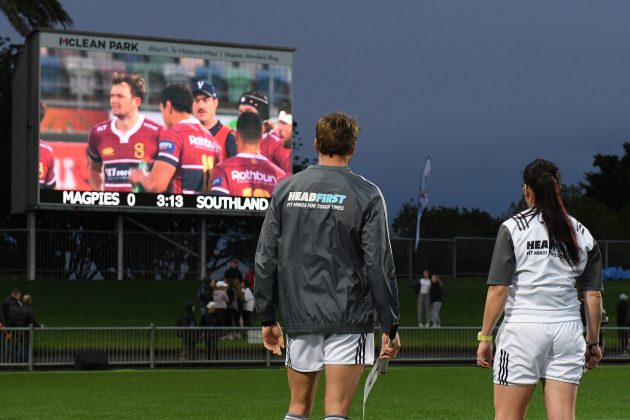Officials dwelling over incidents on screen can frustrate those keen to crack on with the game. But does the greater accuracy make it worthwhile? Read our June 2020 debate
Face-off: Should match officials be using slow-motion replays?
JEBB SINCLAIR
Former Canada back-five forward
“The players and the game are so fast nowadays. If you showed most of the game in slow motion it would look dangerous. It makes the hits and the whiplash look more violent than they actually are.
I understand that they need to slow them down to see if the shoulder or arm hits the head first. But if you can’t tell that at regular speed, is it really that bad?
I also understand the need for player safety. But it’s getting to the point where if you slow-mo’d every breakdown or 50-50 garryowen, you could send someone to the bin. And I like the gamesmanship in France where the TV producers pretend they can’t find the right clip to replay and the referee ends up watching a totally different play on the big screen!
I think referees definitely use slow-motion replays as a crutch. Any difficult decision, they go upstairs. It really slows the game down. At home, watching it on TV, it’s not too bad because you have commentary.
But out on the field for the players, it can take a lot of momentum away from either team just because you’re waiting for so long. And the fans in the stadium have to wait for ages as well.
Instead, it would be interesting to give each team captain three ‘challenges’, to ask the referee to go upstairs to check questionable foul play. If it’s worthy of a card, they get to keep that challenge; if not, they lose one.
Similar to the NFL but instead of the coach being able to see a quick replay and throw a flag, the captain would have to make a snap decision on the field. Because he saw the infraction or because a team-mate says, ‘You should have another look at that, mate’.”

Full-on: Jebb Sinclair takes on the Ireland defence during Canada’s 2015 World Cup campaign (Getty)
KEITH LEWIS
Founder of RugbyReferee.net
“The Television Match Official (TMO) has been part of our game since 1999. And why is that? To help ensure the big game-changing situations are handled accurately. And over the past 20 years, they’ve been tweaking the process to make sure that it stays fit for purpose.
For a period, slow-motion replays were used too much and that caused games to be dragged out. But with the new High Tackle Sanction Framework, there has been much less use.
Most referees will only now ask for slow-motion replays for proving where a point of contact is when it comes to foul play. Using the HTSF leads to different outcomes depending on what part of someone hits what.

Pause button: awaiting a replay during this year’s France v England match in Paris (MB Media/Getty Images)
Slow-mos serve a great purpose in selling those decisions to those watching in the stadium or on television. Those replays prove that the officials are looking at a head/neck contact or a body one.
They are also a crucial tool on or around the try-line, when we have to get the proof of the ball hitting the line before a foot goes into touch, or vice versa. Those are huge decisions that demand accuracy.
Those moments aside, referees only want replays in real time. Only that way can you see things being clear and obvious. Slow-mos can remove the context of the full action, and if TMOs are having to slow things down then it’s not clear and obvious.
But rugby needs to decide whether to use the technology we all have to get the right outcomes. If we do, then slow-mos are part of that. The referees and the TMOs know that, and so don’t want to rush things and so risk losing accuracy.”
What do you think? Email your views to rugbyworldletters@futurenet.com
This debate first appeared in the June 2020 issue of Rugby World.





